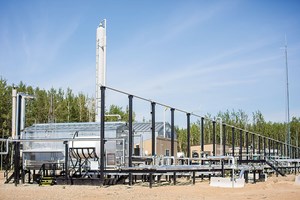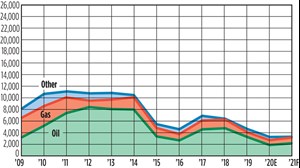Special Focus: 2021 Forecast & Review – Canadian E&P
The oil and gas business had an exceedingly difficult time in 2020. There are signs that activity may be improving, but it’s hard to compare against a year that felt like rock bottom, and to forecast in the shadow of a pandemic.
There was a time when politicization of the oil patch was a concern, and the threat of opportunistic politicians was real. Now, we see why. The oil patch has become the battlefield for idealogues seeking to force an energy transition that no economy can withstand, on people that have no conception of the price they will pay.
Overview. Virtue-signaling politicians across North America, fawning over millionaire celebrities and polarized media, have put “Big Oil” squarely in their crosshairs. Between President Biden’s cancellation of the US $8-billion Keystone XL pipeline (and restrictions on the U.S. industry), plus Canadian Prime Minister Trudeau’s sustained and devastating attacks on oil and gas, producers across the continent have every right to be pessimistic about their future. It is starkly ironic that diminishing the Canadian and American oil supplies serves only to increase both countries’ dependance on oil from foreign countries run by despots, with little or no regard for environmental protection.
Initial figures from Statistics Canada indicate that the Canadian economy shrunk by about 5% in 2020, the worst year on record since the federal agency began measuring growth. A big reason is the decline of the oil and gas industry, which hit all-time lows in several categories.
Drilling, spending and layoffs continued to dominate the Canadian landscape, particularly in Alberta. In the unofficial oil capital of the country, Calgary, downtown vacancy rates are at record highs, hinting at a potential existential crisis for the heart of the oil patch.
Regardless, there are some signs that the year ahead may set the industry back on the path of recovery. It’s hard to put too much stock in some of the numbers recorded in 2020. Drilling and land sales numbers plummeted, but a significant portion of that was in response to Covid-19, not underlying market fundamentals, as government restrictions limited or eliminated normal work conditions. In addition, as worldwide travel slowed, refined products demand also fell.
Oil transportation issues. The Canadian government’s collective shrug over Keystone may seem surprising, but given officials’ purchase of the Trans Mountain pipeline expansion project in May 2018, it follows that the importance of Trans Mountain—and its completion—have risen substantially as a result of Keystone’s demise. The owners of the pipeline can’t help but benefit as a result. Industry observers believe that once the expansion is complete, much of the bottleneck for Alberta crude will disappear.
And, as environmentalists celebrate the death of Keystone, crude-by-rail shipments will continue to grow, meaning the safest means of delivering oil has been eliminated in favor of one of the least safe—railways; further testament to the bewildering mindset of the anti-oil crowd and the politicians that rely on their support.
In Alberta, the death knell for Keystone has hit particularly hard, leading to immediate layoffs and an Albertan government considering its options after agreeing to “provide financial support to Calgary-based TC Energy Corporation to help advance construction of the KXL pipeline. This investment included C$1.5 billion in equity investment in 2020 and a C$6 billion loan guarantee in 2021,” according to the government of Alberta website. Not surprisingly, Alberta Premier Jason Kenney has been particularly vocal in his criticism of President Biden’s decision, and Prime Minister Trudeau’s lukewarm response.
Still, some pundits suggest Keystone may have led to an oversupply of export capacity with the Trans Mountain expansion, Enbridge’s Line 3 replacement project that runs from Hardisty, Alberta, to Superior, Wisconsin (with a price tag of C5.3 billion on the Canadian side and US$2.9 billion on the American side), and, of course, further expansion of crude-by-rail capacity.

Other economic/regulatory factors. Meanwhile, as the oil and gas industry struggles with tens of thousands of layoffs and a murky future, Ottawa has announced a national hydrogen strategy, which officials claim will create a self-sustaining hydrogen sector that will generate up to $50 billion in revenues by 2050. The good news is that this new sector will require substantial quantities of natural gas, Fig. 1. How sustainable it will be without government subsidies is a key unanswered question, however.
Despite all the uncertainty, there are signs that a modest turnaround may be in the cards for 2021. Governments are resuming land sales after they were suspended partway through 2020. An early oil price rally has put some shine on 2021. Drilling numbers are already showing year-over-year improvements, and recent activity forecasts reflect a more optimistic view.
The federal carbon tax, expected to generate billions in revenue for the federal government, remains in place, but one positive aspect is that all provinces that established their own carbon taxes have achieved equivalency with the feds. If they had failed to do so, their constituents would have been subject to two carbon taxes, instead of one.
Also on the positive side are tentative indications from industry that they may be willing to increase spending this year, recognizing that most companies tightened their expenditure belts significantly in 2020. Most have noted that spending could drop, if circumstances worsen. A crude price drop would almost certainly bring back reductions in spending plans for 2021.
On the mergers and acquisitions front, there were some expectations that activity would increase last year over the C$8 billion in deals completed in 2019, and those expectations were realized, with activity reaching about C$29 billion last year. The proviso is that most of that came from one deal: Cenovus Energy’s C$23.6 billion takeover of Husky Energy. As a result, it is expected in most quarters that M&A activity should regress from these levels in 2021.
And, of course, the low level of the Canadian dollar—which was languishing around the US 78-cent mark early this year versus the U.S. dollar—provides a buffer. This benefits the export-driven oil and gas industry, which ships substantial volumes of oil and gas south to U.S. customers.
Drilling. It should be no surprise that drilling numbers declined last year—industry was on track for historic lows throughout most of 2020. When the dust settled, there were only 2,771 wells drilled across the country, according to Daily Oil Bulletin (DOB) records, a decrease of more than 50%. Of these, 67% targeted oil, and more than 95% were developmental wells.

According to Canadian Association of Petroleum Producers records, there were 3,259 wells drilled (including 398 stratigraphic tests), the lowest drilling total in Canada since the early 1960s, Fig. 2. In Alberta, DOB said that drilling fell 46.8%, to 1,283 wells drilled, compared to 2,410 the year before. In Saskatchewan, drilling was down 46.1%, with 1,018 wells drilled, versus 1,890 in 2019. Ironically British Columbia fared comparatively well in 2020, despite the best efforts of its avowed anti-oil provincial government. Operators drilled 349 wells last year, down just 4.1% from 364 in the previous year. And in Manitoba, drilling fell 49.5%, to 112 wells in 2020, compared to 222 in 2019.
World Oil survey results indicate more of a mixed bag. The Canadian Association of Petroleum Producers is projecting drilling to remain almost flat, increasing just over 1%. The most optimistic response was from Manitoba, where they are forecasting an increase according to provincial records. to 150 wells drilled, up more than 80%. And in British Columbia, the province is forecasting a modest increase of just over 4%, to 364 wells.
Overall, forecasts a modest 1% increase in drilling this year in Canada.
Land sales in 2020 must be considered with an asterisk, as the Alberta government’s decision to halt all sales from the beginning of April until mid-November, and British Columbia suspending sales from March onward, have negatively skewed overall totals. According to Daily Oil Bulletin records, the industry shelled out just C$38.16 million in 2020, falling almost 78% from the $172.25 million collected in 2019. In contrast, industry set the record high of $5 billion in 2008, during the last boom.
In Alberta, spending came in at $29.7 million, a drop of 77% from last year’s total of $131.5 million, marking the lowest total ever collected annually. British Columbia brought in just under $57,000 before sales were halted, down by more than 99% from the $14.7 million collected in 2019.
Saskatchewan, on a full slate of land sales, pulled in $8.1 million, a decrease of 68% from 2019’s total of $25.4 million. Manitoba took in $293,303 last year, compared to $606,340 in 2019.
As a bellwether of upcoming activity, one could look at 2020 land sales and conclude that industry may be on its last legs in Canada. The year ahead will likely be one of the most important in Canadian history, as the future of the oil and gas industry appears to hang in the balance. If the past is any indicator, look for innovation and cost-cutting to save the day for the country’s resilient oil patch.
- The last barrel (February 2024)
- E&P outside the U.S. maintains a disciplined pace (February 2024)
- Prices and governmental policies combine to stymie Canadian upstream growth (February 2024)
- U.S. producing gas wells increase despite low prices (February 2024)
- Executive viewpoint: TRRC opinion: Special interest groups are killing jobs to save their own (February 2024)
- U.S. drilling: More of the same expected (February 2024)
- Applying ultra-deep LWD resistivity technology successfully in a SAGD operation (May 2019)
- Adoption of wireless intelligent completions advances (May 2019)
- Majors double down as takeaway crunch eases (April 2019)
- What’s new in well logging and formation evaluation (April 2019)
- Qualification of a 20,000-psi subsea BOP: A collaborative approach (February 2019)
- ConocoPhillips’ Greg Leveille sees rapid trajectory of technical advancement continuing (February 2019)


